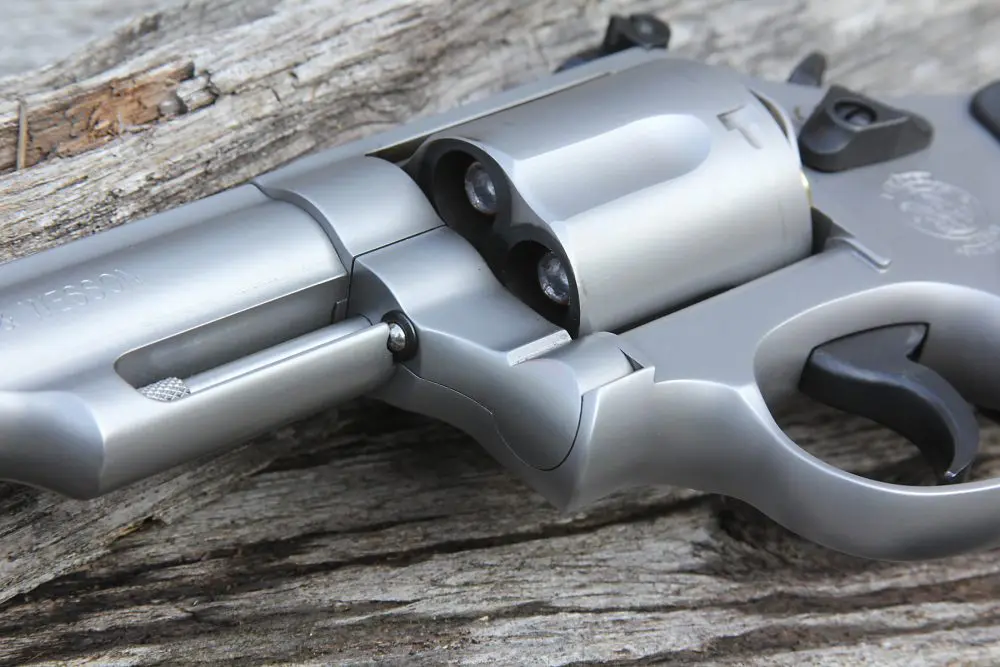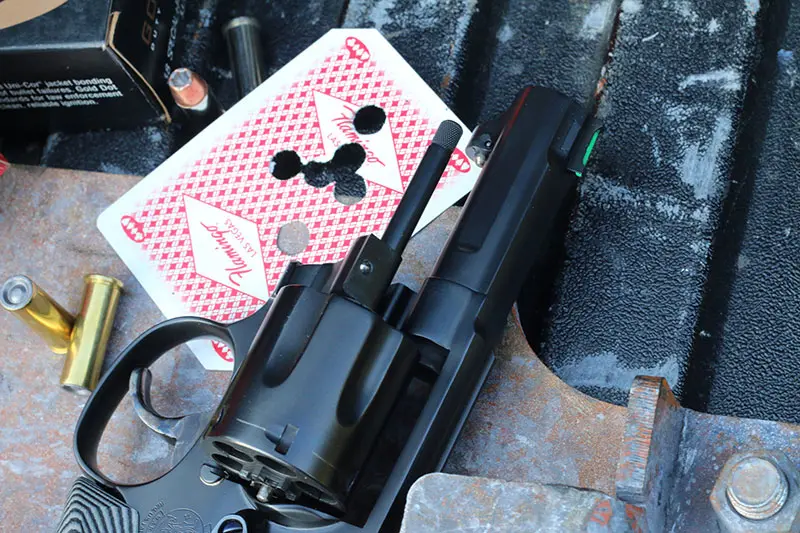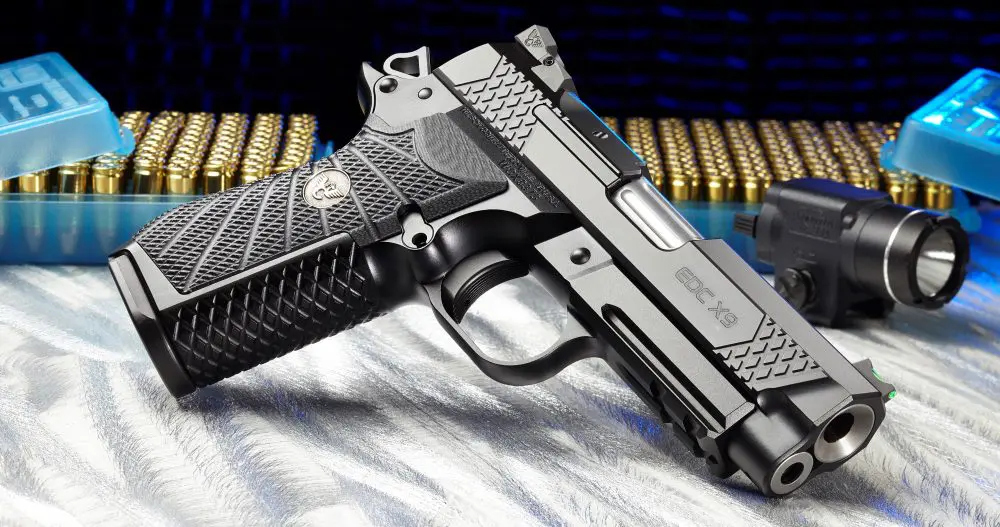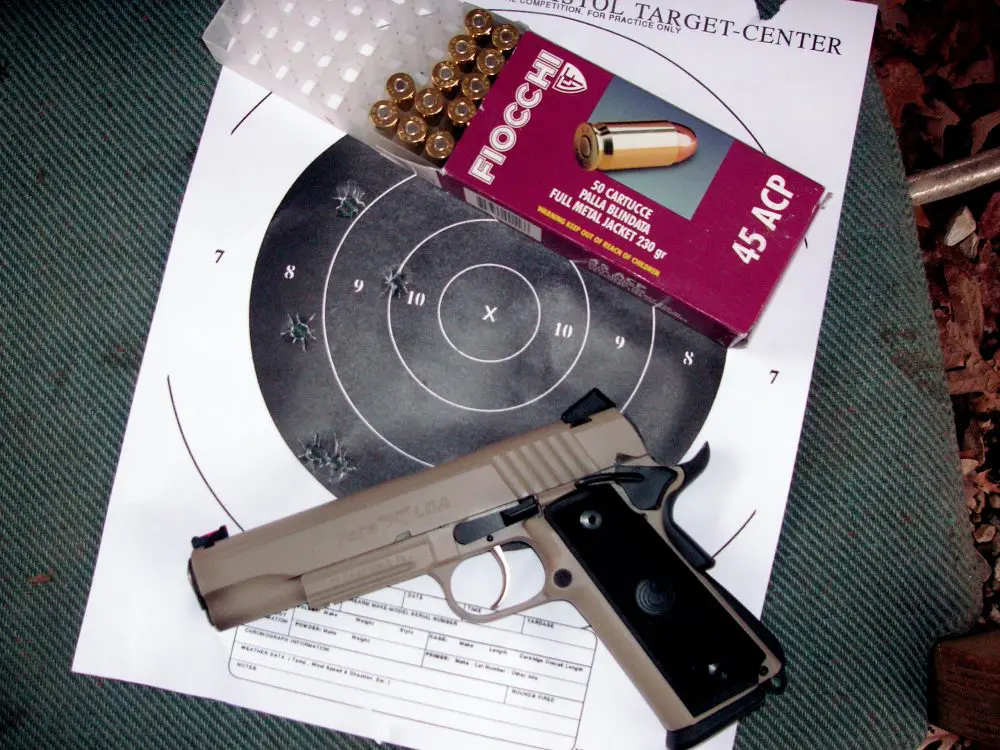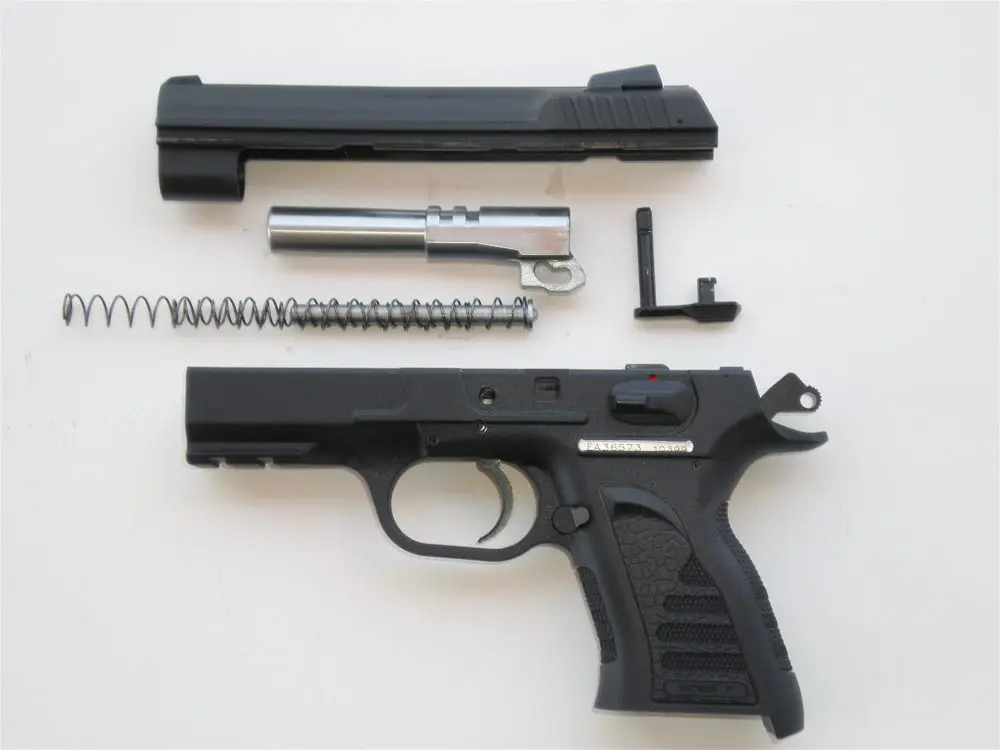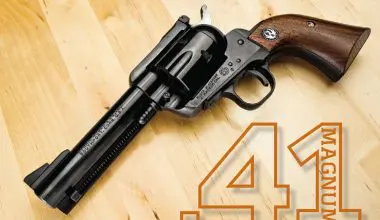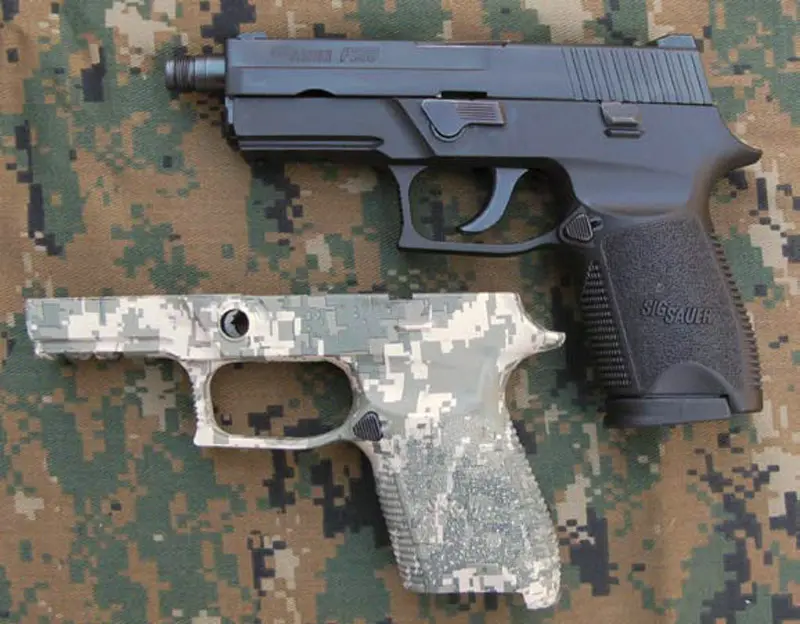
Its larger siblings have already established the positive reputation of the Subcompact P250. This pointand- shoot pistol is the epitome of the KISS (Keep It Simple Stupid) principle, and most gunners agree that it has the smoothest and slickest double-actiononly (DAO) trigger on the market today. Revolver shooters love this trigger, and the only complaint that has been voiced to me is that it has too long a stroke for speed shooting.
Pro shooting champion Todd Jarrett advised that this can be overcome by not riding the trigger throughout its compression and extension, but coming off it completely and contacting the inside of the trigger guard with the trigger finger to insure it’s reset. At close ranges, trigger recontact can be followed by a “slap” and straight pull-through. At longer ranges, the trigger can be staged.
Table of Contents
SIG ACADEMY TECHNIQUE
SIG Sauer Academy director George Harris is a big fan of the P250 and has observed that the Jarrett technique and the difference between slapping and jerking is difficult to teach all but the most experienced shooters. George related to me that at the academy, he and his staff “teach the constant contact method, because it is what makes sense to the student and is evident in its early-on success. We analogize operating the trigger like we operate a car’s gas pedal, smooth in both directions. The majority of the shooters we encounter have guns too big for their hands in the first place. This being the case, it is virtually impossible to slap the trigger parallel to the gun because the trigger finger isn’t long enough.”
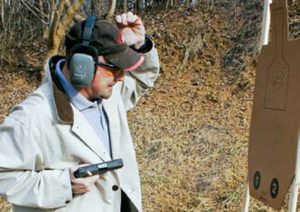
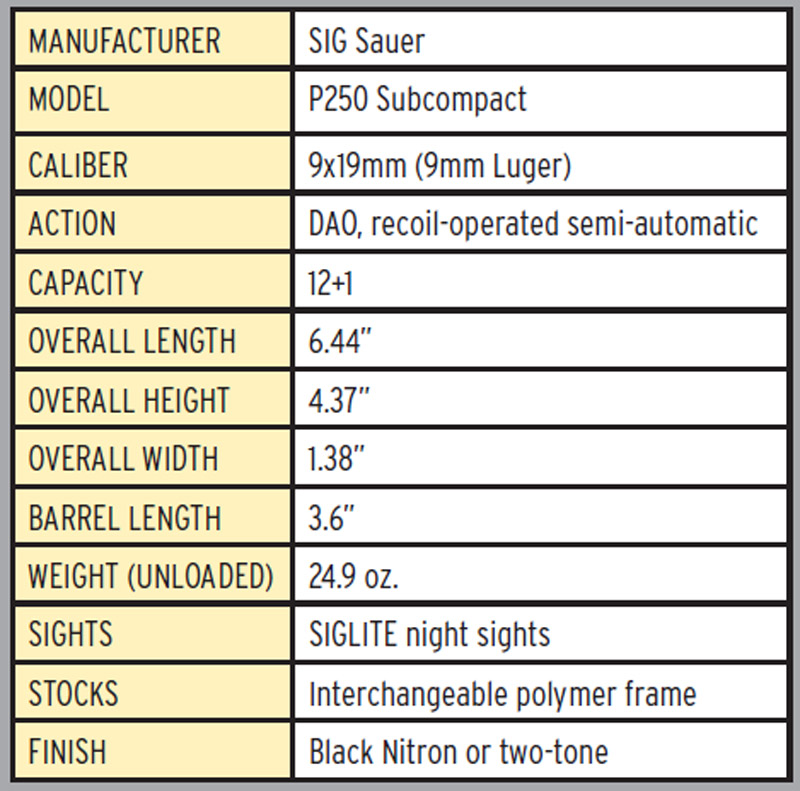
George also believes that there is a strength factor involved. He advised, “As the trigger finger tires, there is increased likelihood that the entire hand gets involved to keep things going, and the muzzle is jerked or milked off target when the trigger is manipulated. Until shooters reach master class levels, it is unlikely that they can coordinate their vision with their hands to the point of determining if one method is significantly better than the other.
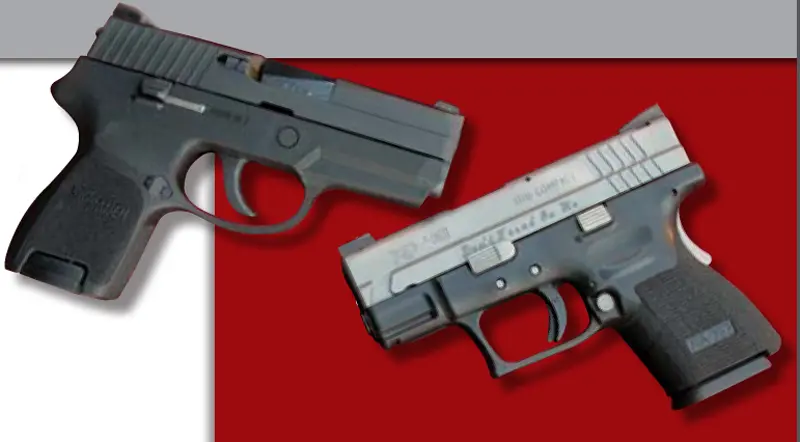
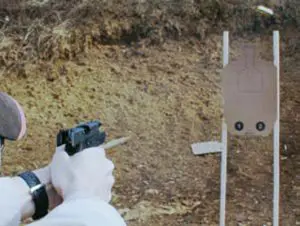
“The downside of the constant contact method is that it conditions the trigger finger to a specific range of motion and that may initially cause difficulty when transitioning to a different gun with a different trigger type. Nevertheless, it still is and will always be—get the muzzle on target and operate the trigger to fire the gun, causing the bullet to exit the muzzle, while the muzzle remains on target.”
In my own case, I can pull the trigger through quickly and then finish with a slower press for a precise shot. A short dwell or interval between rounds might be critical for competition shooting, but splits between multiple shots of .18 seconds versus .20 seconds probably make little terminal difference to a violent threat.
CHANGES TO SUBCOMPACT P250
Winner of two NRA “Best in Class” Golden Bullseye awards in 2009, the P250 Subcompact retains most of the DNA of its bigger brethren but, in addition to overall size compression, there have been other cosmetic changes that obviously affect holster selection and preclude it from accepting underbarrel accessories.
Its trigger guard has been rounded and light/laser rails have been eliminated.
The pistol’s magazine well is deeply cut rather than relieved as it is on its larger predecessors, to permit removing magazines with the thumb and forefinger in the event of non-ejection. As a result, the sub-compact uses a different magazine that is not interchangeable with the compact and full-sized models. Unfortunately, unlike Springfield Armory and FN, SIG Sauer has decided not to include a second magazine, let alone an extended one, in the sub-compact pistol kit. I consider at least one additional magazine a basic component of any pistol package, and it works very well for the above-mentioned SIG competitors.
Other changes include grip stippling that has replaced the original coarser checkering. It surrounds the grip’s circumference and, while the stippling texture is very abrasive, it resembles the fine grit of skateboard tape.
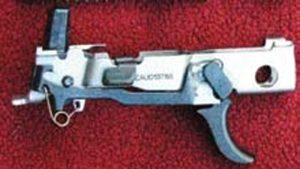
number, the module is considered the gun.
The area above the magazine release has been bilaterally relieved to facilitate index finger reach to the trigger without putting lateral pressure against the frame. However, the Subcompact still shares SIG’s revolutionary removable fire control assembly (FCA) module that permits the shooter to easily reconfigure his sidearm to four different calibers, three different grip sizes, and trigger and slide lengths at will—and also makes thorough cleaning a cinch.
This module contains the pistol’s serial number and is therefore considered the gun. Ergonomically speaking, the removable FCA creates a slight negative. In order to accommodate the lengthy hammer, the grip’s beavertail had to be lowered. As a result, the hand is positioned well below the bore’s axis, and it is not as efficient in reducing muzzle flip.
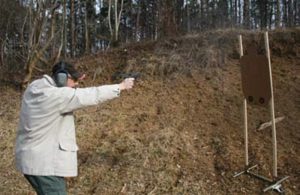
FEDERAL AIR MARSHAL PISTOL
The P250 is available in tough black Nitron and two-tone finishes. Versatility is its middle name, and this attribute is particularly germane to the current shortfalls in ammunition supply (which, however, are improving). This considerable flexibility has not gone unnoticed. The word is that the gun-savvy Federal Air Marshals will be replacing their airworthy P229s with P250s in .357 SIG calibers.
Slide releases are ambidextrous, and the magazine release can be relocated to the gun’s starboard side to accommodate southpaws. The metallic sights are SIGLITE night sights, and the dovetailed front blade is adjustable for windage. Several different front and rear sight height combinations are available to change elevations as required. These pistols are totally snag free, and the stud-like hammer is secreted within the slide and cannot be thumb cocked. The Subcompact P250 is virtually a sealed system and substantially denies access to its interior by external dirt and debris.
My sample was in 9x19mm. In a light weapon, this is the largest caliber that the average shooter can handle well. All calibers offered in the P250 series share the same-sized slide in width, and it reminds me of the beefy slide found on the P229 pistol. At 1.06” in width, it is pretty hefty for a 9mm.
Although the Subcompact shaves about five ounces in weight and approximately two inches in height from the full-sized 9mm, its shortened grip is the only feature that actually contributes to enhanced concealability.
However, three-inch barreled guns still hit pretty hard, and long ago the FBI determined that was the minimum barrel length for agent issue when they fielded the S&W M13 .357 Magnum revolver.
Although the Subcompact P250’s tube measures over three inches from muzzle to breech face, its bullet-to-muzzle exit, or bullet runway, is approximately 2.5 inches. Average 9x19mm muzzle velocity decrease per inch of reduced barrel length is approximately 45 to 50 fps.
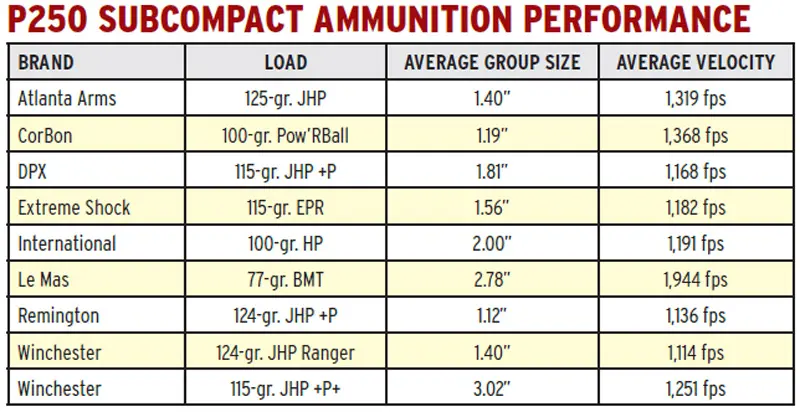
RANGE TIME
Firing the P250 is very revolver-like and reminds me of my old Kilgore cap pistols that I routinely “killed” my playmates with in my earlier life. This point-andshoot gun is so simple and easy to operate that it, like all firearms, must be properly secured from children when not in an adult’s possession. SIG Sauer provides a sturdy cable lock for that purpose.
The Subcompact P250 is combat accurate. Its short sight radius and DAO trigger slightly handicap it, but threat engagement out to 25 yards is quite feasible for most shooters if they stage the trigger.
Ejection is positive, with spent cases landing two to four feet to the shooter’s right, indicating that the recoil spring is of proper weight for the loads fired. For personnel new to the P250, avoid rhythm shooting, shoot its front sight, and your rounds will print where you want them to.
ALMOST 2000 FPS
From a handheld rest at 15 yards, the tightest five-round group of 1.12 inches was produced by Remington 124-gr. +P. The highest velocity of 1,960 feetper- second (fps) was obtained from Le Mas 77-gr. Blended Metals Technology’s NATO round. This velocity threshold is phenomenal performance from a subfour- inch barrel.
Sold only to military and police, this is the strangest ammunition I have ever encountered. I know it will fragment only in warm living tissue and acts like a solid bullet in cold gelatin test media. It was cold on range day, so I was careful to keep the test ammunition relatively warm in the cab of my truck, because low temperatures generally mean lower bullet velocities.
Warm Le Mas cranked out consistent velocities in the 1800+ fps range. After sitting out in a 40-degree day with wind chill for about an hour, I decided to chrono the Le Mas samples again, and velocities jumped up to an average of 1900+ fps. Le Mas principal Stan Bulmer advised that in many cases, their ammunition acts in reverse when heated and gets faster when cold. Go figure….
The Subcompact was dry and not lubricated, and yet reliability was perfect.
The grip is short and fairly slim for a high-capacity 13-round pistol, so there’s not a lot to hold on to. However, with one or two hands, the light P250 handles recoil well. With two hands, muzzle movement is straight up and down. With one paw, it recoils up and to the left. Keep a firm grip and the pistol will stay put and not torque away from alignment.
The P250 is a close-quarters blaster, so speed shooting works best within a 21- foot envelope. Accelerated trigger work will frequently result in shots bucked low, so save the warp-speed stuff for conversational or interrogation distances.
CONCLUSIONS
The engineers from Germany and Exeter have created a very interesting and versatile handgun system.
When the British SAS transitioned from their Army-issue FN High-Power pistols to the SIG Sauer P226 9mm, older vets had trouble adapting to the new trigger system, while new members with little pistol experience took to the new gun quickly. This may also occur initially with our Air Marshals who have spent years with the P229. However, it’s going to be a matter of patience—and practice—until the P250’s trigger becomes a subconscious act.
The P250 in any of its iterations will make an excellent primary or secondary backup weapon, and it can be acquired for a very reasonable price.
